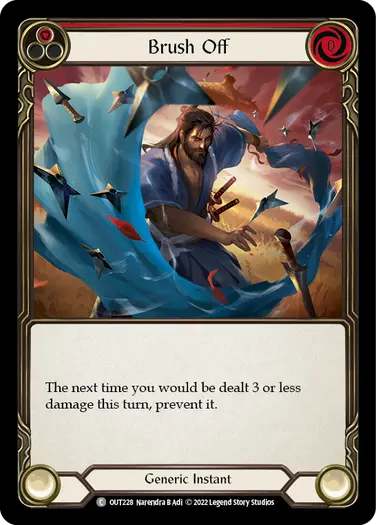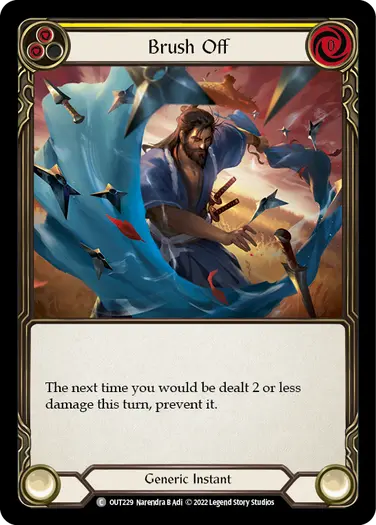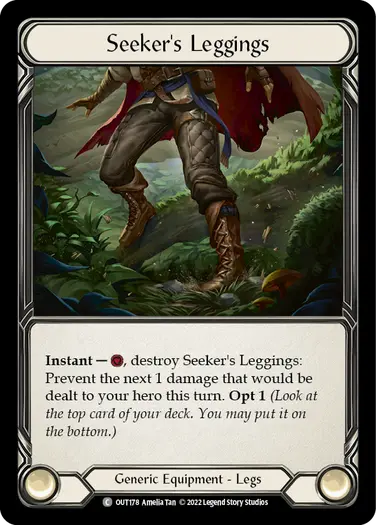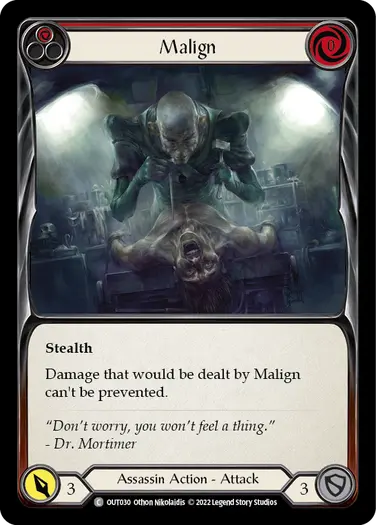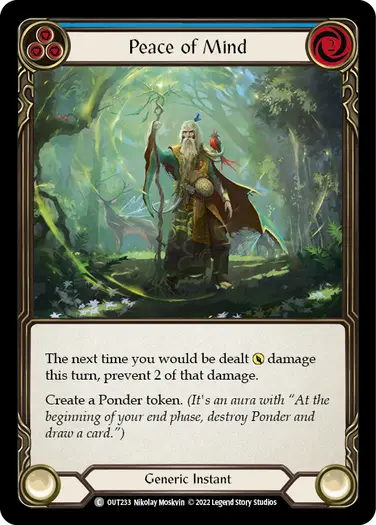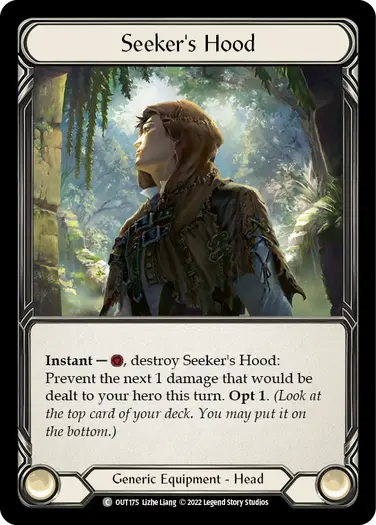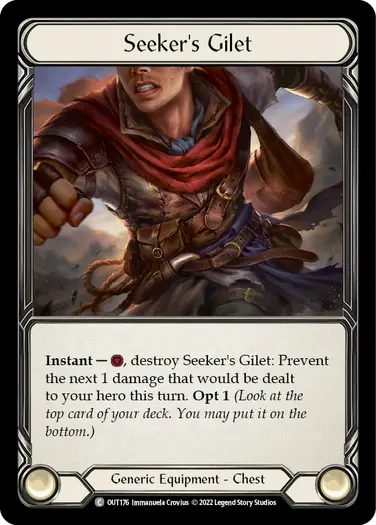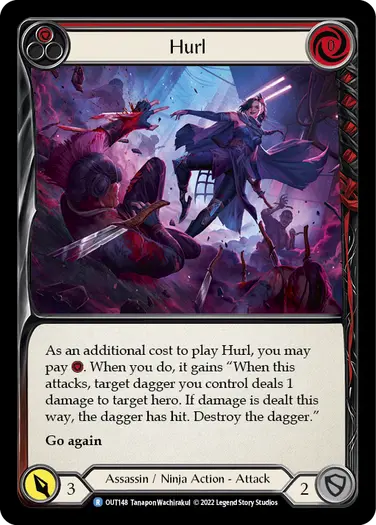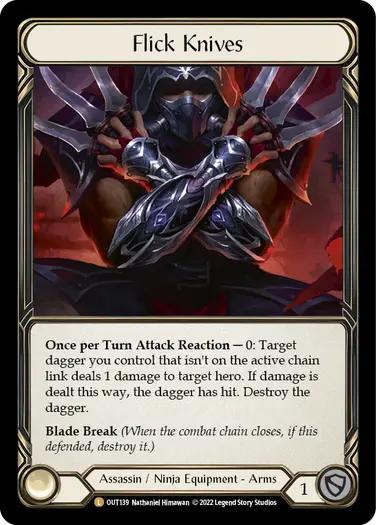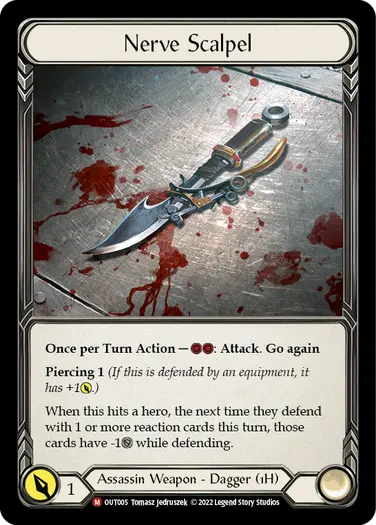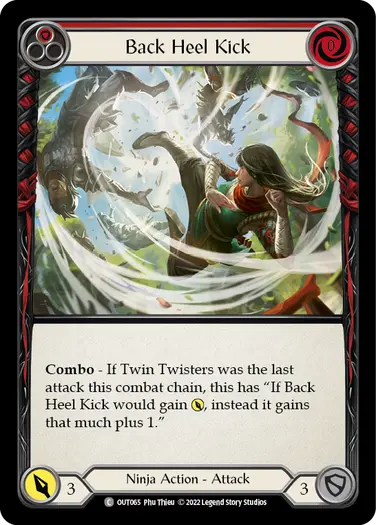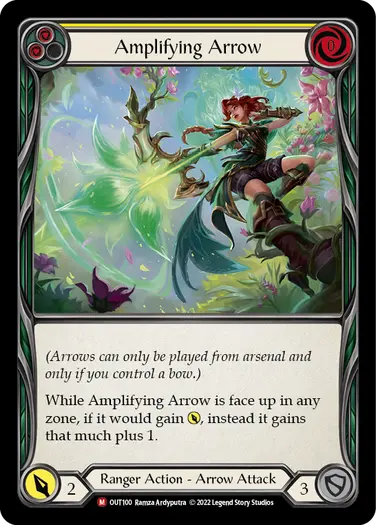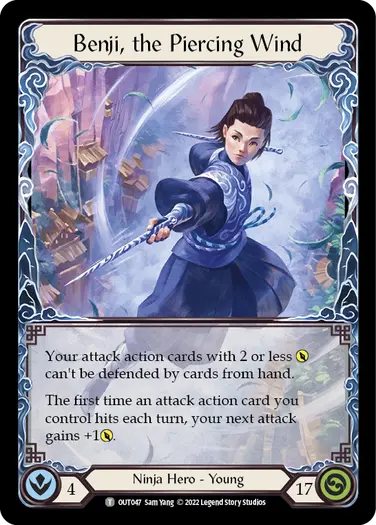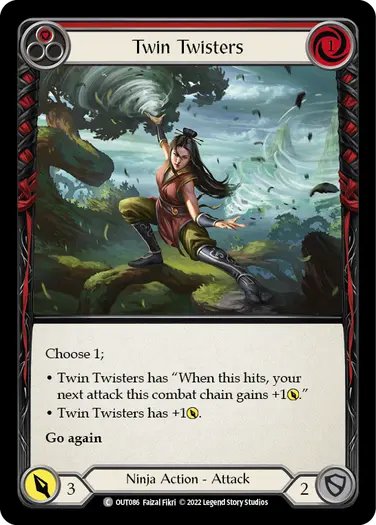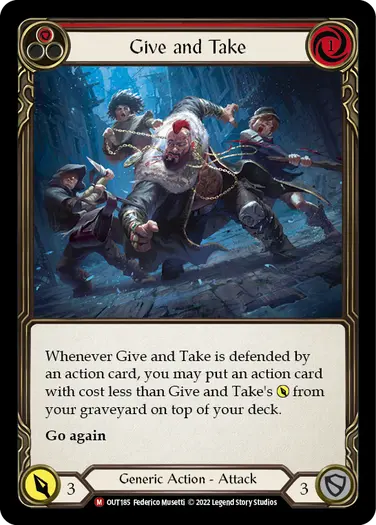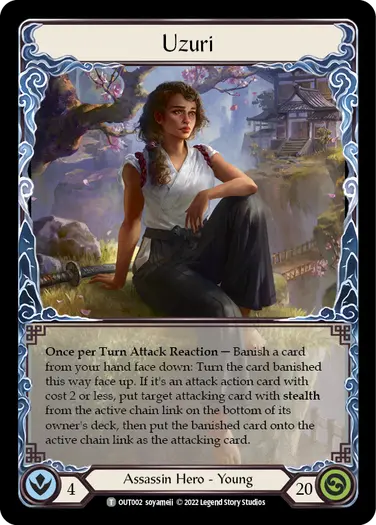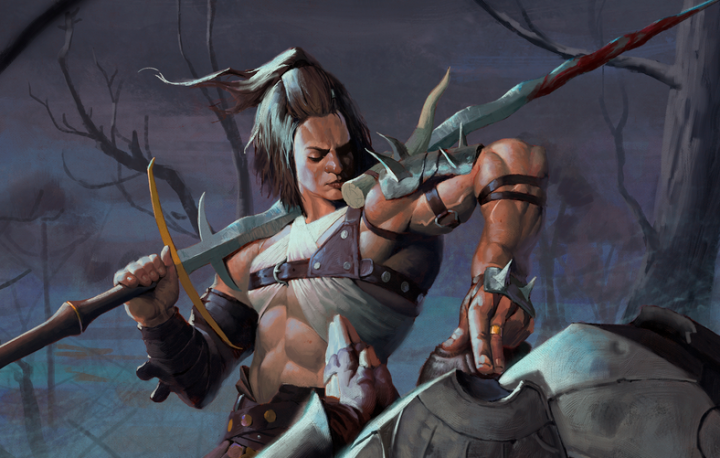Gear up and get ready for the Outsiders pre-release this weekend, with another rules reprise from Joshua Scott. Today is about the ins-and-outs of prevention effects, and some other new tid-bits brought to you by the Outsiders booster set.
When does Brush Off actually prevent damage?
Brush Off creates a prevention effect that applies only once to the next event of damage that meets its condition. The condition is that your hero would be dealt damage, and that the amount of damage is X or less (or exactly 1 for the blue cycle). This condition is checked “just” before you’re about to actually be dealt the damage – in the case of attacks, this is after the total amount of damage is calculated (power – defense = damage). If the event of damage does not meet the condition for Brush Off, then its prevention effect isn’t active and does not apply.
Nic plays Brush Off (red). Tyler is about to deal 4 damage to Nic. Brush Off does not apply because it is only active against the next event of damage that is 3 or less. After Nic takes 4 damage, Tyler is about to deal 2 damage to Nic. Brush Off applies here because it is the next event of damage that is 3 or less, thus it prevents Nic from taking the 2 damage.
If you have two or more prevention effects that would apply to a damage event, you (as the player that controls the effects) are allowed to choose which of the active prevention effects will apply. Prevention effects are applied one at a time, and whether a prevention effect is active to apply (whether its condition is met), is checked after each effect is applied. This means that with another prevention effect you may be able to have Brush Off apply to events of damage larger than X.
Nic plays Brush Off (red) and activates Seeker’s Leggings. Tyler is about to deal 4 damage to Nic. Brush Off does not apply because it is only active against the next event of damage that is 3 or less – this means that Seeker’s Leggings applies first, as the only currently active replacement effect. The damage is reduced to 3, and Brush Off is now active because the damage is 3 or less, thus it prevents Nic from taking the 3 damage.
Also, it is worth noting that although Brush Off (and similar cards in Outsiders) is an instant; it needs to resolve before the prevention effect is active. The opponent might still respond to playing Brush Off with an instant that deals damage, and at that point the effect of Brush Off will not be active.
How do I stop damage from Malign or Murkmire Grapnel?
The text on Malign and Murkmire Grapnel text reads: "Damage that would be dealt by [this] can't be prevented."
This is a static-continuous effect that stops prevention effects from reducing the damage dealt by the attack. It does not stop the defending hero from adding defending cards to the chain link which reduces the damage in the damage step of combat.
The cards in Outsiders affected by this effect include Peace of Mind, Brush Off, and the Seeker’s equipment suite. When damage can’t be prevented, the prevention effect “tries” to reduce the damage, but is stopped short of actually changing it. The two types of prevention effects are
- For prevention effects that apply to the next single event of damage (Brush Off and Peace of Mind), the effects are consumed trying to prevent the damage and will not apply to any other damage later in the turn.
- For prevention effects that apply to a total amount of damage over the turn (Seeker’s Hood, Gilet, Mitts, and Leggings), the prevention amount is not reduced and the effect may still apply to damage events later in the turn.
Tyler attacks Nic with Malign (red) with go again. Nic plays Peace of Mind (blue) and activates Seeker’s Hood. Nic does not defend and takes 3 damage because Peace of Mind and Seeker’s Hood can’t prevent the damage from Malign. Tyler attacks Nic again with an attack with 3{p}. Nic does not defend and takes 2 damage because Peace of Mind was consumed by the previous attack (despite not preventing anything), but Seeker’s Hood is still active and prevents 1 damage.
How does Vambrace of Determination work against prevention effects?
Vambrace of Determination has an activated ability that, when resolved, creates an effect that modifies prevention effects when they apply to an event of {p} damage. In short, the next prevention effect that tries to reduce {p} damage is basically made less effective by 1. For Vambrace of Determination to apply, the prevention effect does not need to ONLY prevent {p} (e.g. Blessing of Serenity), the prevention effect just has to apply to the event of {p} damage being dealt (e.g. Brush Off against an attack dealing {p} damage).
- For prevention effects that apply to the next single event of damage (e.g. “the next time you’d be dealt damage, prevent 3 of that damage”) it would simply prevent 1 less of that damage (e.g. it would essentially become “prevent 2 of that damage”).
- For prevention effects that apply to a total amount of damage (e.g. “prevent the next 3 damage dealt to your hero”) it would simply reduce the prevention amount (e.g. it would essentially become “prevent the next 2 damage”).
If a player has two or more prevention effects active, they may choose which of those effects are applied first. The effect they choose to be applied first is what Vambrace of Determination will modify.
Tyler attacks Nic with an attack with 1{p}. Nic plays Peace of Mind (blue) and activates Seeker’s Gilet. Tyler activates and resolves Vambrace of Determination. Nic does not defend and would be dealt 1 damage. Because both Peace of Mind and Seeker’s Hood effects are active for this event of damage, Nic may choose which effect to apply. Nic chooses to apply Peace of Mind (prevent 2 damage), which is reduced by Vambrace of Determination (prevent 1 damage), thus it prevents Nic from taking the 1 damage. Because there is no more damage left to prevent Seeker’s Hood may still apply to another event of damage later in the turn.
If a prevention effect specifies “The next time you would be dealt X damage this turn, prevent it.”, the amount of damage the effect prevents is exactly the amount of damage that would be dealt before the effect applies (e.g. If you would be dealt 3 damage, the effect prevents 3 damage). This means that Vambrace of Determination may still reduce the prevention amount, causing damage to be dealt.
Tyler attacks Nic with an attack with 2{p}. Nic plays Brush Off (red) and Tyler activates Vambrace of Determination. Nic does not defend and the attack would deal 2 damage. Brush Off is active (the damage is 3 or less), and tries to prevent it (prevent 2 damage); Vambrace reduces the prevention amount by 1 (prevent 1 damage). The 2 damage is reduced to 1 damage, and thus Nic is dealt 1 damage.
What happens when a dagger deals damage from Hurl or Flick Knives?
Hurl and Flick Knives both allow a player to deal damage to a player but destroying a dagger in the process. There are several key factors that you should keep in mind regarding these effects:
- The dagger itself is not considered an attack when used with Hurl/Flick Knives. Being used this way does not create an additional chain link, and it does not break the current combat chain.
- If the dagger deals damage, it is considered a hit event and triggers on-hit effects as though the dagger has hit.
- If the dagger has hit this way, the active chain link is considered to have hit. The attack itself on the active chain link is not considered to have hit this way.
- You can target a dagger that you control that you attacked with on a previous chain link; but if the dagger deals damage this way, it does not count as that previous chain link hitting.
- The dagger is destroyed regardless of whether it deals damage or not. When the dagger is destroyed, it is put into the graveyard.
There is a major difference between a chain link hitting and the attack on the chain link hitting for the purposes of cards like Mask of Momentum and Whirling Mist Blossom. If anything “hits” on a chain link then the chain link is considered to have hit. If both a dagger deals damage due to these effects and an attack hits in the damage step in the same active chain link, this situation does not count as two separate chain links hitting. A chain link simply hits or it doesn't.
Tyler controls Mask of Momentum and has hit Nic once this combat chain. Tyler attacks Nic with an attack action card with 3{p}. Nic defends with a card for 3{d}. During the reaction step Tyler activates and resolves Flick Knives (with Harmonized Kodachi), dealing 1 damage to Nic. Tylers chain link has hit, but Mask of Momentum doesn’t trigger yet. Tyler attacks Nic again with an attack action card, it hits, and because it's the third or higher chain link in a row to hit, Tyler will draw a card from Mask of Momentum.
For assassin daggers specifically, if the effect deals damage, the dagger is considered to have hit and will trigger the dagger’s effect. Each of the Nerve Scalpel, Scale Peeler, Spider’s Bite, and Orbitoclast daggers have on-hit effects that would trigger this way, and generate a delayed-triggered effect that applies to the next time the hero defends with cards of a certain type.
Nerve Scalpel’s delayed-triggered effect in particular does not retroactively apply to reactions that are already defending, but does trigger and apply to the next time the hero either declares attack reactions as defending cards (during the defend step) or when a defense reaction of theirs resolves and becomes defending (during the reaction step). In this way, using Flick Knives with Nerve Scalpel in response to a defense reaction played by the opponent may reduce the effectiveness of that reaction.
Tyler attacks Nic with an attack action card with 4{p}. Nic plays a defense reaction with 4{d}, but in response Nic activates and resolves Flick Knives (with Nerve Scalpel), dealing 1 damage to Nic and triggering Nerve Scalpel’s effect. The defense reaction resolves, and Nerve Scalpel’s delayed-triggered effect applies, reducing it to 3{d}.
How do Back Heel Kick and Amplifying Arrow gain power?
Back Heel Kick (when the combo condition is met) and Amplifying Arrow each have an effect that modifies how continuous effects (that increase power) apply to them. For many effects such as Come to Fight, the effect is applied when the attack action card is first put onto the stack. If there are two or more effects that would apply as the card is played, they are applied one at a time, and if the effect is one that increases the power of the card, the value is increased by 1.
Effects that decrease power are not affected by Back Heel Kick or Amplifying Arrow. Effects that stop cards from gaining power (e.g. Snag, Buzzsaw Trap) will prevent the modified power being gained from those sources.
Tyler is playing as Benji. Tyler attacks Nic with Twin Twisters choosing the first mode. The attack hits, which triggers its own and Benji’s effects. Tyler announces they are playing Back Heel Kick. As Back Heel Kick is put onto the stack, the effects from Twin Twisters and Benji are applied, and each of them are modified by the effect of Back Heel Kick. This applies two +2{p} effects to Back Heel Kick for a total of +4{p}.
When and how many times does Give and Take trigger?
Give and Take triggers once each time an action card defends it on the combat chain. If the defending hero declares two or more defending action cards during the defend step, the Give and Take triggers two or more times (once for each action card).
However, if Give and Take is put onto a chain link with Uzuri’s hero ability, it does not trigger for cards that are already defending on that chain link because the defend-event has already occurred and Give and Take has missed that window.
Tyler is playing as Uzuri. Tyler attacks Nic using an attack with Stealth, and Nic defends with two action cards. During the reaction step, Tyler activates Uzuri, banishing Give and Take. When the ability resolves, Give and Take is put onto the chain link, but does not trigger because the action cards are already defending.
